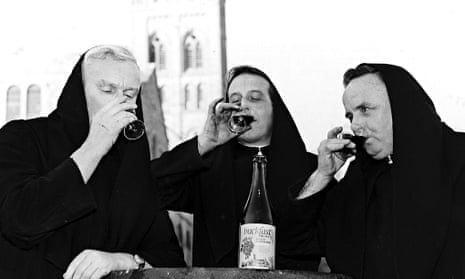Mixing alcohol with caffeine has thrown up some illustrious drinks over the years: the Cuba Libre, the caffe corretto and the vodka Red Bull. No combination of alcohol and caffeine, however, has proved as notorious as buckfast, a drink that is credited with almost supernatural powers of destruction.
Buckfast Tonic Wine is neither very strong, at 15% alcohol, nor very cheap, at around £7 for 75cl. Nor is it really a wine, based as it is on mistella – unfermented grape juice fortified with ethanol.
It was created in the 1880s by Benedictine monks who, fleeing persecution in France, came to Buckfast Abbey in Devon. It’s changed somewhat over the years and the modern drink now contains various flavourings, preservatives and a large dose of caffeine. I’ve read claims that it’s the chemicals in buckfast – sodium glycerophosphate, dipotassium phosphate and disodium phosphate – that cause the special effects. These may somewhat contradict the folksy image the monks like to portray, but they are completely normal food additives. The drink is related to Pineau des Charentes from Gascony, and communion wine which are both made from mistella. One theory has it that buckfast was first popularised in Glasgow by Celtic fans in the 70s due to its similarity to communion wine.
Whereas in the rest of the world buckfast is drunk sedately, in Glasgow it’s become the drink of choice for “neds” – a peculiarly Scottish version of the hooligan. Because neds commit violent crimes and drink buckfast, there have been claims that the buckfast itself is responsible for crime. “The Buckie made me do it,” has become the classic defence in Glaswegian assault trials. Catherine Stihler, Labour MEP for Scotland, claimed that Buckfast “causes untold misery in communities across the country.”
We’ve been here before. The magistrate Henry Fielding, author of Tom Jones, wrote in 1751 that gin caused a “new kind of drunkenness.” More recently the tabloid press dubbed English football hooligans “lager louts” as if it was the fizzy beer that was the problem rather than that many supporters were more interested in fighting than football.
So far, the Buckfast Abbey monks have refused to take the blame for the criminal behaviour of a small minority of their customers despite much pressure from the press, politicians and the police. The monks even managed to obtain an apology from Strathclyde police after one officer told a shopkeeper to stop selling it.
It’s not an easy drink to find in England. I’ve only had it once at a party in north London. I remember it tasted a bit like undiluted Ribena mixed with Benylin. Afterwards I glassed my best friend and went on a rampage down Crouch End Broadway screaming: “the Buckie made me do it!”

Comments (…)
Sign in or create your Guardian account to join the discussion